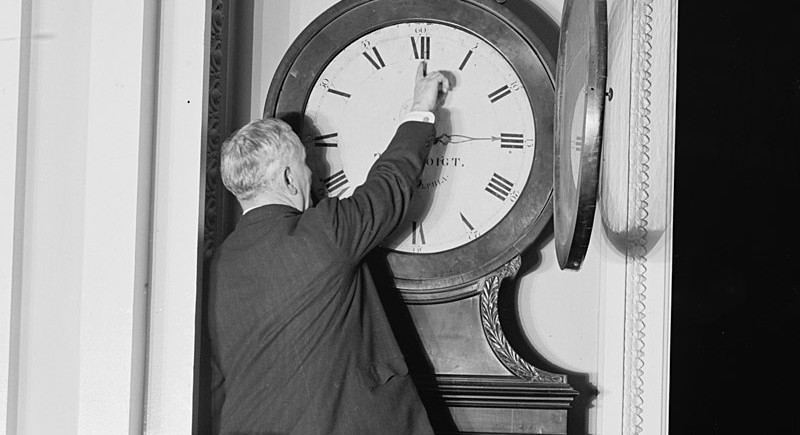Everything You Need to Know About the Upcoming Fall Time Change
Every November, most Americans turn their clocks back an hour, marking the end of daylight saving time and the return to standard time. The shift brings earlier sunsets, darker evenings, and plenty of confusion about what exactly changes — and why.
What seems like a simple clock adjustment is actually shaped by decades of legislation, energy debates, and ongoing efforts to end the twice-a-year switch. Here’s what to know about how the fall time change works and what it means this year.
History Behind the Time Change

Image via Wikimedia Commons/Harris & Ewing Collection
Daylight saving time in the U.S. became official in 1918 through the Standard Time Act, signed by President Woodrow Wilson during World War I. Germany and Austria were the first countries to adopt the practice in 1916 as a wartime strategy to conserve fuel. The idea was simple: modify the clocks to maximize daylight during waking hours. Benjamin Franklin famously joked in 1784 about waking people with bells and cannons to save daylight, but he never proposed clock modifications.
After World War I, the U.S. discontinued the policy, only to bring it back during World War II. Inconsistent rules followed for decades until the Uniform Time Act of 1966 created a nationwide standard. The schedule was altered again in 2007 under the Energy Policy Act of 2005, which set the current timing. Today, daylight saving time operates under that law, with standardized start and end dates across participating states.
What Happens on November 2, 2025
On Sunday, November 2, 2025, at exactly 2 a.m., clocks across most of the U.S. will turn back one hour to 1 a.m. This will bring earlier sunrises and sunsets, which means that there will be more morning light and less daylight during the evening. The alteration affects 48 states and Washington, D.C., all of which will be following the established daylight saving schedule.
The U.S. Department of Transportation oversees these changes, as daylight saving time officially falls under federal authority. States that follow the system adjust twice a year—once in March to move forward, and once in November to fall back. The difference may come off as minor, but it can impact daily schedules, sleep patterns, and even safety. Many people notice the difference immediately in how early it gets dark after the change. And though digital devices typically update automatically, analog clocks continue to require manual resets.
Where Daylight Saving Time Does Not Apply

Image via Pexels/Ray Bilcliff
Most of the United States observes daylight saving time, but several areas remain on standard time all year. Hawaii has opted out due to its consistent sunrise and sunset times throughout the year. Arizona also stays on standard time, with the exception of the Navajo Nation, which follows the federal DST schedule.
U.S. territories like Puerto Rico, American Samoa, the U.S. Virgin Islands, Guam, and the Northern Mariana Islands, also do not participate. These regions have opted out legally and remain on standard time without seasonal transitions. Their decisions are allowed under the Uniform Time Act, which gives states and territories the right to forgo daylight saving time.
However, states that wish to make daylight saving permanent must wait for congressional approval. Several states have passed bills expressing the desire to stop changing clocks, but federal law still blocks any permanent adoption of DST without national action.